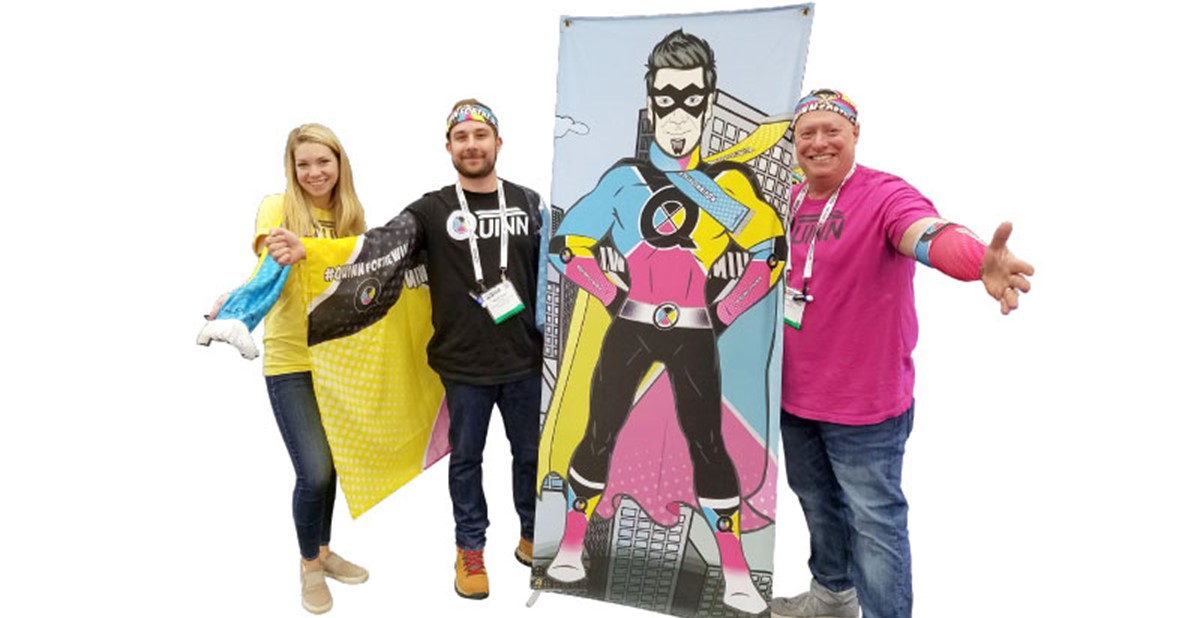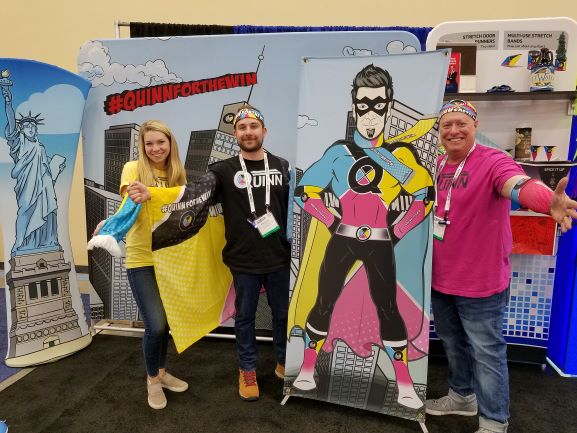Marketing: Build A Powerful Trade Show Promotion

At the PPAI® Expo in January most booths experienced steady traffic, but others were packed. Sure, some were the big-name suppliers who always have a following, but the others weren’t just banking on their reputations—they were doing something that captivated, magnetized, engaged and entertained passersby.
To get that kind of traffic, these exhibitors used a technique called “experiential marketing,” otherwise known as event marketing, live marketing, on-ground marketing or even “brand activation” for those Madison Avenue types.
Whatever you call this type of promotion, when done right it is just smart, fun, targeted and interactive marketing that takes place in big spaces or small ones. Here’s what you need to know to make it work for marketers of all kinds, plus an inside look at how one exhibitor employed it especially well.
What It Is
Experiential marketing is a type of marketing that directly engages or immerses a target audience in a live event by involving them in some type of interactive entertainment or learning environment. To be successful, the experience must be mutually beneficial and fun for the exhibitor and participant. Well-crafted experiences don’t just tell participants who you are. Rather, they allow the audience to step inside the brand—and become a part of it.
Why It Works
This type of marketing can forge lasting relationships with customers, increasing the sales cycle over the long haul, according to Ad Week. Experts also believe that live events help users better understand a product 65 percent of the time and help simplify processes 58 percent more often. Experiential marketing works particularly well with Millennials, who cite live experiences as the best memories of their lives. This generation also feels compelled to share their experiences with peers, particularly on social media; 49 percent usually share videos of these branded events and the photo share rate is even higher.
What’s even better is that 100 percent of event experts believe the results of experiential marketing are always enhanced by including branded promotional products as a stay-behind tangible memory of the experience.

Quinn Flag Company team members, from left, Jen Clapper, Mark Tress and Bruce Kolbrener
invite passersby into the booth during the Expo.
Essentials You Need To Do It Right
There are three core essentials that serve as a guidepost for creating and then adhering to the event experience you are trying to create for your company or a client. First, establish a single goal. What is the purpose of the event? What do you want to accomplish from the event?
To answer these questions, you need to zero in on No. 2—your target audience. Picture a single member of this audience. Who is this person? What is their day like? What is their age, gender, demographics, role and pain points? Creating a persona of your target audience is essential before you can determine how you are going to captivate them.
And No. 3, but no less important, is determining the single message you want to deliver. You don’t need multiple messages, just one. It must be simple, easily understood, easily conveyed and woven throughout the experience. And it is essential that your prospects experience this message in some way for it to be effective. (Then and only then do you select a theme or products to include.)
Other Essentials. How do you want your audience to feel after the experience? What do you want them to do? (For example, do you want them to share their contact information, vote for something, buy something? Be specific. If you ask them to do too many things, it won’t happen.) What is your budget for the added experience? If your experience is to generate better, higher-quality leads, then the additional budget may be justified.
The Scene. Since you are setting up an experience, think about the environment you are creating and the venue you are trying to replicate. Since most people need help imagining where you want them to be, you may need to invest in a backdrop, props or costumes to help them immerse themselves in your setting. Examples of a venue might be a busy office, a football stadium, heaven—whatever. The setting also helps convey the fun when they are sharing the experience on social media through photos or video.
Sharing It. So how will your target audience share the experience? If that’s part of your marketing plan (and it should be!) you’ll need to remind them to do so. Will you have people in place to help them pose or to take a photo or video? Will you ask them to share a post? Register individuals as a “Liker” on your social sites and have booth staff in place to encourage the action you want to happen.
Staffing Your Experience. There are several players that need to be involved to deliver an effective experience:
- The Wranglers. Be sure you have vivacious, gregarious, no-fear talent in the booth to encourage folks to participate. If not, people will just pass by.
- The Closers. These are members of your sales team. They can do product demos and qualify prospects, but they must understand the entire experience enough to make sure the initial message is carried through their presentation.
- Administrator. This is the person managing the event, the booth and the leads. This is the person redirecting talent, managing breaks, answering questions and filling in for others. This person knows how the experience should work from every angle and ensures things are flowing smoothly. If not, on-the-spot changes must be made for better flow.
Uh-oh! What Can Go Wrong?
To ensure you get the maximum value from your experiential marketing, watch out for these glitches.
No promoting ahead of time. You must promote every promotion, before and after.
No rehearsal. When people don’t rehearse how things will go, things can go wrong. Know what will entice show attendees to participate, how you want the message delivered and how to follow up on objections beforehand, with all players practicing their roles. A quick pre-show meeting before the show opens does not cut it.
Expecting too much. If you don’t anticipate what you want the customer to do, the next steps needed and the time to do that, you could lose the prospect. Above all, the activity must be simple, quick, easy and fun.
Not everyone participates. What do you have to do for those people? What message do you deliver to them? How can you qualify them quickly and get them to a salesperson if they are good prospects?
No fun. If your activity seems like a chore, people won’t participate. You can make almost anything fun and interactive but it’s all a matter of how you do it. You may need help from someone skilled in planning experiences to help you work out a strategy.
Plan the follow-up ahead of time. Weeks before the event, determine a follow-up plan. What communications will you launch after the event? Who will do them? How quickly? If you wait until two weeks after an event, most memories have dissipated.
One Supplier Who Did It Right
Quinn Flag Company, which is celebrating its 25th year in business, has grown from a flag manufacturer to one of the largest full-color fabric printers in the promotional products industry. By continually learning what was important to its customers and what the company needed to be successful in the market, Quinn evolved its product line to include 6,700 products in over 60 product categories from banners and trade show displays to table covers and even cheering products. The company has earned five-star, A+ ratings with SAGE but wanted to truly set itself apart from the other banner and exhibit companies on the show floor.
The goal for its experiential marketing project at the Expo was to show off the company’s full-color printing capabilities rather than just its products, and have show attendees interact with those products in a fun way that encouraged shares on social media.
First, they considered what type of environment conveys color and heroic service. A cityscape and a comic book superhero, of course. The scene was a typical 30-foot inline booth. The marketing team created a full-color backlit cityscape backdrop accentuated with colorful paint drippings and a Quinn comic book superhero for participants to pose with. To carry through the theme, Quinn booth staffers dressed in t-shirts in basic CMYK (cyan, magenta, yellow and black) colors and waved fun cheer wear products. A steady stream of show attendees accepted the challenge to dress up and pose in superhero garb while staffers snapped photos and encouraged their posting to social media using the hashtag #QUINNfortheWin.
The post that gathered the most Likes won a free, fully customized 10-by-10-foot canopy tent.
The prize was on display in the product demo area of the booth. Even visitors who didn’t have their photo taken were drawn in by the colorful backdrops and were greeted by the sales team.
Halfway through the three-day show the Quinn team reported it already had more leads—and more qualified leads—than it had gotten from the entire 2018 show. In addition, the company’s social media shares were way up and the number of followers had also increased. Within a few days of the show, the company sent emails to all the leads from the show and followed up with phone calls. It was the company’s best response ever from a trade show.
Quinn’s booth experience is a great example of how any company can achieve record results without a Fortune 500 budget by understanding the principles and how-to’s of successful experiential marketing.
––––––––––––––––––––––––––––––––––––––––––––––––––––––––––––––––––––––
Mary Ellen Sokalski, MAS, owns the marketing agency, the Scarlet Marketeer, and has been creating “wow” experiential marketing promotions for the past 37 years for industry companies. Maryellen@scarletmarketeer.com

